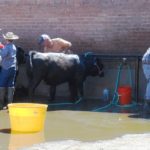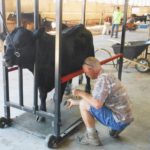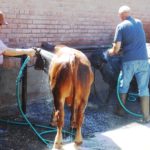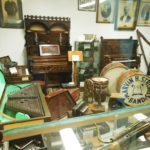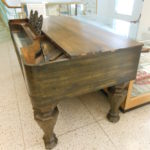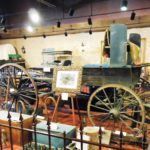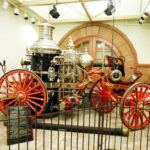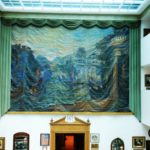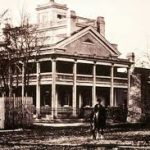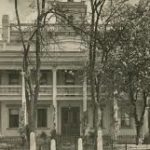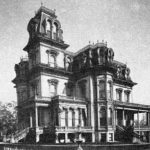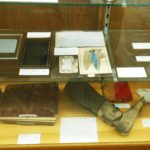In Missoula, realizing that we were scheduling trips to an awful lot of scattered venues, we devised three new alternate routes. In the final analysis, we decided to save the lengthy trek down to Bryce Canyon — one of the few major national venues we’ve missed – for yet another trip. We also skipped Ogden, Utah – figuring the Osmonds wouldn’t miss us — and returned, instead, to Salt Lake City for a couple of days. (Part of the motivation was grinding truck brakes that were overdue for service.)
The State Fair was in progress, and we spent an hour or two walking around it. The most fascinating discovery was getting a behind-the-scenes look at preparation for the bovine beauty contest. At dog Specialty Shows, we call it Conformation. Baths and grooming are essential in both situations!
In 2012, during our Journey, we spent a week in SLC. But Dot spent most of it flying back to Pennsylvania for her mom’s 90th birthday party. While she was gone, I took a quick swing through the Pioneer Memorial Museum. We went back this time to give Dot a chance to see it. The Museum sits just below the Capitol building. It was built by the Daughters of Utah Pioneers in 1950, styled to replicate the Salt Lake Theatre, demolished in 1929 but well evoked in the Museum’s interior design.
The purpose of the Museum, and its founding association, is the preservation of the history that defines Utah – the pioneers who came across the plains by any means prior to the arrival of the railroad in 1869. Thousands upon thousands of artifacts are cataloged and organized in logical categories. Some, such as pianos, clothing, medical equipment, lace making, hair art, musical instruments, military gear, et al, are categorized by function. Others, like the Golden Spike, the 1947 Centennial, Pony Express and Brigham Young’s Beehive, Lion and Gardo (not a typo!) houses, deal with endeavors. Still others are important relics, including Brigham Young’s wagon (yes, the one in which he traveled from Nauvoo to SLC) and The American Fire Engine No. 1, delivered to SLC in 1902 and fully restored to operating condition in 1994.
- Collection of Musical Instruments
- Abraham Hunsacker’s Piano, 1862 (see story)
- Endowed Carriage House, including Young’s Pioneer Wagon
- The 1902 restored American Fire Engine
- Beds galore!
- Original Pioneer Theatre curtain restored.
Oh yes, the well-traveled piano. Abraham Hunsaker lived near Nauvoo, IL and joined the Mormons after they settled there. He went west to Salt Lake City as one of the earliest pioneers. After living there for a period of time, he traveled back to Illinois to retrieve his piano. His second journey bogged down in Wyoming, where he buried the piano wrapped in bison robes, only to find his way back a year later to retrieve it!
A note on Brigham Young’s houses. The Beehive House, built in 1854, was the residence of Young and his only legal wife (Mary Ann Angel) and his first polygamous wife, Lucy Ann Decker. The Lion House, built two year later, housed most of his other wives and many of his 57 children. He commissioned Gardo House in 1882 for his 25th — and favorite — wife, Harriet Amelia Folsom as her residence and as a reception hall where she would served as hostess. Amelia, daughter of architect William Folsom, was young, talented and refined. Her father was involved in the design of the Salt Lake Tabernacle, Pioneer Theatre and three area Temples. “Gardo” is believed to be a term from a Spanish novel that was one of Young’s favorites. Unfortunately, he died before its completion. The two succeeding LDS presidents used it as their residence. Pictures are all borrowed from Internet searches — begging forgiveness rather than asking for permission!
- The Beehive House
- The Lion House
- The Gardo House
There are two relics of particular interest. One is a black coat worn by Willard Richards, an 1847 pioneer who was in the room in the Carthage, Illinois jail when Joseph Smith was murdered. The other is a wooden leg, fashioned and worn by John Rowe Moyle. An 1856 handcart pioneer, he was a stonemason and stone carver who worked on the Temple. Nothing unique there, until you discover that he walked 22 miles in the wee hours of every Monday from his farm in Alpine and walked back home on Friday night to tend the farm and his family – even after he lost a leg below the knee when a cow kicked him.
There’s more information on this museum in the Salt Lake City chapter of my e-book of the three year trip: www.schipperhaven.org/journey. Even with this three hour second visit, there was still more to see — we have yet to go through any of the three historic houses! Moab was calling us, but I hope we’ll return.

